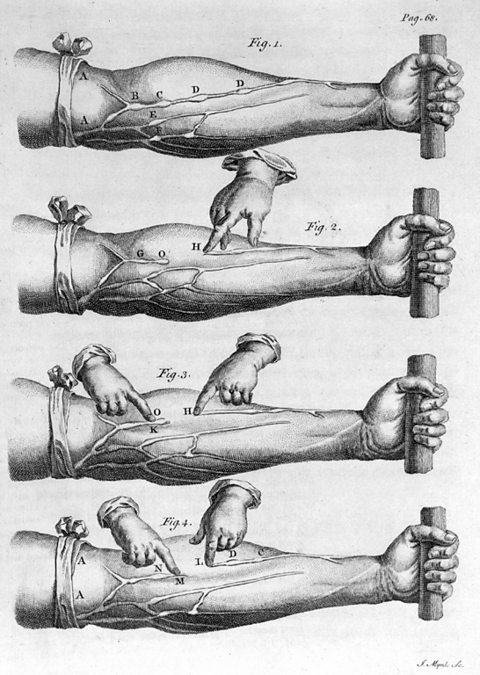William Harvey
Watch to recap the work of Vesalius and Parรฉ before finding out about the work of William Harvey.
- William Harvey was an English doctor who was born in 1578.
- He studied at the University of Padua in Italy, where Andreas Vesalius had carried out his dissectionThe action of cutting apart the body of an animal or plant to examine its internal structure. and work on anatomyThe science dealing with the structure of animals and plants.
- Harvey achieved his medical qualifications and returned to England.
- He worked for most of his career at St Bartholomewโs Hospital in London.
- He was a fellow of the Royal College of PhysiciansAn organisation set up in 1518 to share ideas and set high standards for qualified physicians in England.
- He went on to become the physician of James I.
Harvey's ideas on circulation

GalenA Roman doctor who lived from AD129 to approximately AD203. He revived Hippocrates' ideas and encouraged bloodletting as a treatment, after learning about anatomy from treating injured gladiators. had said that blood was burned up by the body, like fuel on a fire. He said new blood was made in the liver. These ideas were widely believed by doctors in the Middle Ages.
Harvey dissected frogs, which have a slow pulse rate, and showed that blood was pumped around the body by the heart. He also discovered the role of valves in blood vessels, which make sure blood only flows in one direction.
Harvey published a book in 1628 called An Anatomical Account of the Motion of the Heart and Blood. His high profile as physician to the king helped Harveyโs work to be widely shared. The book included details and diagrams of experiments Harvey had carried out to support his findings.
Why was Harvey significant?
Harveyโs work was important as it was another example (after Vesalius) of Galenโs work being proved to be incorrect. This encouraged other doctors to continue to question and challenge ancient ideas.
The idea of circulation also led to doctors attempting blood transfusionWhen people are given blood via a drip. from animals to humans. These were unsuccessful, as blood groupEvery person has a unique blood group (type of blood) that is determined genetically. The four possible groups are A, B, AB and O. had not yet been discovered.
In the longer term, Harveyโs work was significant in the development of successful blood transfusions. When Karl Landsteiner discovered blood groups in 1901, blood transfusions became possible.